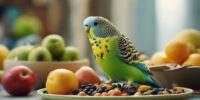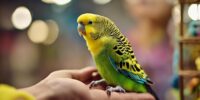What Are the Key Differences Between Wild and Domestic Parrot Behaviors?

Wild parrots exhibit different behaviors compared to their domesticated counterparts. In the wild, parrots are highly social creatures that form strong bonds with their flock members. They communicate through various vocalizations and body language to establish hierarchy and maintain social relationships. Wild parrots also spend a significant amount of time foraging for food, which provides mental stimulation and physical exercise.
On the other hand, domestic parrots may exhibit different behaviors due to their environment and interactions with humans. They may rely on their human caregivers for social interaction and mental stimulation, which can affect their behavior and social skills. Domestic parrots may also display behaviors such as mimicry, learned from their human companions, as a form of communication. Additionally, they may show different feeding patterns, as they are often provided with readily available food instead of foraging like their wild counterparts.
Understanding these differences in behavior can help parrot owners provide appropriate care and enrichment for their feathered friends. By recognizing the natural behaviors of wild parrots and adapting their care to meet these needs, owners can help ensure the well-being and happiness of their domesticated parrots.
Nesting and Reproduction Behavior
Wild parrots exhibit a diverse range of nesting and reproduction behaviors influenced by their natural habitats and social structures. When it comes to breeding habits, different species of wild parrots show variations in their approach. Some species are monogamous, forming long-term pair bonds, while others engage in cooperative breeding where multiple individuals help raise the young. Parental care among wild parrots is generally shared between both parents, with each contributing to feeding, protecting, and teaching the offspring survival skills.
Nest building is a crucial aspect of wild parrot behavior. These birds showcase remarkable skills in constructing nests, using materials like twigs, leaves, and feathers. The choice of nesting sites can vary from tree hollows to cliff crevices, depending on the species and environmental conditions. Mate selection in wild parrots involves intricate courtship rituals, vocal displays, and physical interactions that help establish and strengthen pair bonds. These behaviors are essential for ensuring successful reproduction and the continuation of the species in their natural habitats.
Feeding and Foraging Patterns

In the realm of parrot behavior, the focus now shifts to examining their distinct feeding and foraging patterns. Wild parrots showcase a diverse range of feeding behaviors influenced by their natural habitats. Roosting habits vary among species, with some preferring communal roosts while others roost individually in tree hollows. When it comes to foraging, wild parrots exhibit sophisticated hunting techniques such as cracking nuts with their powerful beaks or using tools to extract insects from tree bark.
Seed preferences play a crucial role in the diet of both wild and domestic parrots. Wild parrots have evolved to consume a variety of seeds, each with different nutritional benefits. In contrast, domestic parrots often receive commercially available seed mixes, which may lack the diversity found in their natural environment. Fruit foraging is another common behavior observed in wild parrots, where they play a vital role in seed dispersal for various plant species.
Understanding these feeding and foraging patterns is essential for providing proper nutrition and enrichment for domestic parrots to mimic their wild counterparts' natural behaviors.
Social Structure and Communication

Parrots, both wild and domestic, exhibit intricate social structures and communicate through a diverse array of behaviors. In the wild, parrots establish social hierarchies within their flocks. These hierarchies are often based on factors such as age, experience, and personality. Dominance plays a crucial role in determining the pecking order, with more dominant individuals having priority access to resources and mates.
Communication among parrots involves a combination of vocalizations and body language. Vocalizations range from loud squawks to soft chirps, with each serving a specific purpose such as establishing territory or signaling danger. Body language, including feather ruffling, head bobbing, and wing spreading, further complements their vocal communication.
Domestic parrots also exhibit social behaviors, forming bonds with their human caregivers and other animals in the household. Understanding parrots' social structures and communication methods is essential for their well-being in captivity.
Flight and Exercise Needs

Wild parrots exhibit intricate flight patterns that are essential for their survival in the wild. This involves long distances, quick maneuvers, and complex aerial displays.
Domestic parrots, on the other hand, may have limited flight opportunities and rely more on exercise through climbing, foraging, and interactive play.
Understanding the differences in flying abilities and exercise habits between wild and domestic parrots can provide valuable insights into their physical and mental well-being.
Flight Patterns in Wild Parrots
Observing the flight patterns of wild parrots provides valuable insight into their natural exercise needs and behaviors. Wild parrots exhibit diverse flight behaviors influenced by various factors such as roosting habits, predator avoidance, migration patterns, and flock dynamics.
These birds often engage in extensive daily flights, covering large distances in search of food, water, and suitable roosting sites. Flight serves multiple purposes for wild parrots, including foraging, social interactions within the flock, and evading predators.
The dynamic aerial maneuvers seen in wild parrots indicate their agility and intelligence in navigating complex environments. Understanding these flight patterns is crucial for meeting the exercise requirements of captive parrots, as it allows caregivers to provide opportunities for physical activity that mimic the natural behaviors of their wild counterparts.
Exercise Habits of Domestics
Domestic parrots have distinct exercise needs, including flight requirements, that must be understood and addressed by caregivers to promote their physical well-being. Playtime routines are essential for domestic parrots to engage in physical activity and mental stimulation. Providing opportunities for play can mimic natural behaviors such as foraging, climbing, and interacting with toys.
Encouraging cage exploration by placing toys, perches, and ladders can help simulate the diverse environments wild parrots experience. Regular out-of-cage time allows domestic parrots to stretch their wings, exercise flight muscles, and maintain overall health. Caregivers should also ensure that the living space is safe for flight and exploration to prevent accidents.
Meeting these exercise needs is crucial for the well-being of domestic parrots.
Comparing Flying Abilities
To understand the comparative flying abilities between wild and domestic parrots, it's crucial to analyze their flight patterns and exercise needs in captivity.
Wild parrots exhibit exceptional flight dynamics, honed through evolution to evade predators and navigate vast territories. Their flight abilities are essential for survival, allowing them to escape predation risks and find food sources efficiently.
In contrast, domestic parrots, often confined to cages, may experience limitations in their flight capabilities, leading to reduced exercise opportunities. This lack of space can impact their physical health and mental well-being.
Furthermore, wild parrots rely on their navigation abilities and flock dynamics during flight to communicate, find resources, and protect themselves. Understanding these differences is vital for providing adequate care for domestic parrots to ensure their overall welfare.
Territorial Behavior

Territorial behavior in parrots can be characterized by the establishment of specific areas that they defend against intruders through vocalizations, displays, and sometimes aggression. Aggression displays and dominance are common behaviors exhibited by parrots when defending their territory. These behaviors are crucial for wild parrots to protect their resources and secure breeding grounds. Vocalizations, including warning calls, serve as a primary form of communication during territorial disputes. Wild parrots often use loud calls to demarcate their territory boundaries and deter potential threats.
Dominant individuals within a parrot group may exhibit more pronounced territorial behavior, asserting their control over a specific area and resources. This behavior helps maintain social order within the group and ensures that resources are distributed efficiently. Understanding territorial behavior in parrots is essential for their well-being in captivity, as it allows owners to create environments that cater to their natural instincts. By providing adequate space and enrichment opportunities, domestic parrots can exhibit similar territorial behaviors in a safe and stimulating manner.
Coping With Stress and Enrichment

Parrots exhibit various coping mechanisms to manage stress and engage in enrichment activities to maintain their mental and physical well-being. Stress management in parrots is crucial for their overall health. Environmental enrichment plays a pivotal role in providing stimulation and preventing boredom in these intelligent birds. By understanding how parrots cope with stress and the importance of enrichment, owners can ensure their feathered companions lead fulfilling lives.
| Stress Management | Enrichment Activities | Benefits |
|---|---|---|
| Foraging opportunities | Toys and puzzles | Mental stimulation |
| Adequate space | Social interaction | Physical exercise |
| Calm environment | Novel objects | Prevents boredom |
| Routine care | Training sessions | Bonding with owners |
| Safe retreat areas | Outdoor exposure | Mimics natural habitat |
Implementing strategies that focus on stress management and environmental enrichment can help reduce behavioral issues and promote the well-being of both wild and domestic parrots. Owners should strive to create a balanced environment that caters to the cognitive and physical needs of these intelligent birds.
Human Interaction and Training

Human interaction and training are crucial components in shaping the behavior and development of both wild and domestic parrots. Positive reinforcement and behavior modification techniques play a significant role in training these intelligent birds. Through the use of rewards like treats or praise, parrots learn to associate certain behaviors with positive outcomes, leading to increased likelihood of repeating those behaviors.
Bonding and trust building are essential aspects of human-parrot interactions. Parrots are social creatures that thrive on companionship and connection. Spending quality time with them, engaging in activities they enjoy, and creating a secure environment fosters a strong bond between the parrot and its human companion. Trust is built over time through consistent interactions, respect for the parrot's boundaries, and understanding its body language cues.
Consistency in training methods is key to successful behavior modification. By establishing clear expectations and boundaries, parrots can learn what's acceptable behavior in a human household. Training sessions should be short, frequent, and tailored to the individual bird's needs and preferences to ensure effective learning and behavior shaping.
Frequently Asked Questions
Can Wild Parrots Be Trained to Talk Like Domestic Parrots?
Wild parrots can be trained to mimic human speech like domestic ones. Vocal mimicry is a natural behavior, but domestic parrots may be more receptive due to socialization. Training techniques play a crucial role in this process, aiding in conservation efforts.
Do Wild Parrots Form Strong Bonds With Their Human Caretakers Like Domestic Parrots Do?
Wild parrots exhibit intelligence and socialization in the wild, forming strong bonds within their flocks. Domestic parrots, on the other hand, thrive on enrichment and communication with their human caretakers, fostering unique relationships based on trust and companionship.
How Do Wild Parrots Handle Being Confined to a Cage Compared to Domestic Parrots?
In response to being confined to a cage, wild parrots exhibit behavioral adaptations to manage stress, lacking social interaction and mental stimulation. Domestic parrots, accustomed to human care, may show more resilience and potentially thrive in captivity settings.
Do Wild Parrots Exhibit Behaviors Like Feather Plucking or Self-Mutilation Seen in Some Domestic Parrots?
In the wild, parrots rarely exhibit behaviors like feather plucking or self-mutilation seen in some domestic parrots. Wild parrots maintain healthy feather care through natural preening behavior, which is vital for communication and socialization within their flocks.
Are There Any Differences in the Lifespan of Wild Parrots Compared to Domestic Parrots?
Wild parrots generally have shorter lifespans in the wild due to predation, environmental factors, and limited access to veterinary care. Domestic parrots, with proper diet and care, can live longer lives, often exceeding their wild counterparts.











